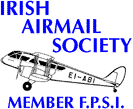
Uniform Foreign Airmail Rates: 1951-1996
On March 1, 1951, Ireland reformed its foreign airmail rates with the introduction of uniform foreign airmail rates. Before this the letter rate was quoted per first 1/2 ounce and varied from 6d (e.g., Egypt) to 1/6 (e.g., Ecuador) according to destination and route.Postal regulations require prepayment of the airmail fee otherwise it is likely that the postal packet will be sent by surface transportation. Insufficiently Paid cachets were applied to underpaid mail that was forwarded by surface transport. Occasionally letters were forwarded by airmail despite underpayment. A special form, intended to collect the deficiency, was sent to the addressor.
The uniform foreign airmail rate has three distinct time frames. The first period is that during which £.s.d. applied. The second started with the introduction of decimalisation on Decimal Day; February 15, 1971, when postal rates were converted to the decimal currency system. Decimalisation saw the introduction of rates that lasted for only four and a half months before a rate reduction for the first steps of letters and printed papers. The last major change came when the Department of Posts & Telegraphs introduced weight metrication for all postal packets on July 25, 1977. The initial weight step for letters and printed papers increased to 20 grams from 1/2 ounce (14.175g.), the next weight step was reduced to 10 grams from 1/2 ounce. Charges were adjusted more or less proportionately.
The definition of foreign in the Irish Uniform Foreign Airmail Rate has changed over time and the extracts below indicate some of the main changes. When the rate started on March 1, 1951, until the 1/3 letter rate was introduced on July 6, 1953, foreign was defined as countries outside Continental Europe, Gibraltar and Malta. The 1954 Eolaí an Phoist (Post Office Guide) shows that the foreign airmail rates applied to all non-European countries. Over time additional countries were included in the All-up service to continental Europe thereby reducing the countries to which the foreign rates applied.
The 1982 Volume II, Foreign Services, Eolaí an Phoist reads:
- First Class mail (letters, letter packets and postcards) for all European countries, Azores, Canary Islands, Cyprus, Cape Verde Islands, Greenland, and Madeira is sent by air, without surcharge, as the normal means of transmission. Air mail labels or other markings should not be used. There is no Second Class air mail service to these countries; to secure air conveyance to Europe such mail must be prepaid at letter or postcard rates as appropriate. For all other destinations a blue air mail label, obtainable free of charge at any Post Office, must be attached to each air mail item at the top left-hand corner on the address side; alternatively, the indications "PAR AVION" or "BY AIR MAIL" may be written boldly or printed in the same position. The absence of an air mail label, may lead to delay. For parcels, a large size air mail label, obtainable free of charge at any Post Office, must be used.
Following the division of the Department of Posts & Telegraphs, on January 1, 1984, into An Post and Telecom Éireann, a distinction was made between EEC (European Economic Community) countries, now EU, and other European countries from February 25, 1985, when, in addition to the 20 gram rate step, a new first step rate of 10 grams was introduced that lasted until December 31, 1991: the EEC/non EEC differential prevails today.
The 1986 An Post Services Guide lists the EEC countries that had their own rates for which air transport was the normal method of transmission and were excluded from the uniform foreign airmail rate. The countries not listed are those that required prepayment at the uniform foreign airmail rate. The EEC countries extract is listed below to show that European countries like, Sweden, Czechoslovakia, Hungary, Switzerland, etc., were now excluded from the European All-up rate:
- Belgium, Denmark, France, Germany (Federal Republic) Great Britain, Greece, Ireland, Italy, Luxembourg, Netherlands, Portugal (inc. Azores, Madeira), Spain (inc. Canary Islands Balearic Islands).
From the beginning express service was available on payment of the Express Fee that was identical for both inland and foreign mail, except for a short period from April 1, 1981, to February 24, 1985, when there was a differential. On January 20, 1992, the Express service was abolished and replaced by Swiftpost, a trackable priority mail service that spans both the foreign and European Community postal rates: £2.00 for all international mail, inc. Great Britain (£1.00 - inland inc. Northern Ireland).
While the Express Fee only guaranteed Express service within Ireland to the point of departure (usually the Central Sorting Office, Dublin), destination countries often gave such mail their equivalent service, and sometimes applied their own cachets. Swiftpost, however, guarantees priority service from the time of posting until delivery. The pre-numbered Swiftpost label is affixed to envelopes in addition to postage, while the receipt portion is given to the sender as a proof of posting certificate. Special Swiftpost stationery, that includes postage up to certain limits, is also available. As has always been normal with all Express services, a vertical blue line is added front and back, but the large design of the label makes this superfluous.
The airmail stamps that were first released on April 7, 1948, with further issues at later dates, were used extensively to pay the uniform foreign airmail rates. The first letter rate step of 1/4 did not have a single stamp available for nearly two years until the An Tóstal 1/4 stamp was issued on February 9, 1953. It was then only correctly valid for the rate for less than five months, before the introduction of the longest running letter rate; 1/3. On December 13, 1954, the 8d and 1/3 stamps were issued for the new air-letter (aerogramme) and letter rates respectively, and both stamps, especially the 1/3, are frequently seen.
Karl Winkelmann
Updated 28 October 2005
